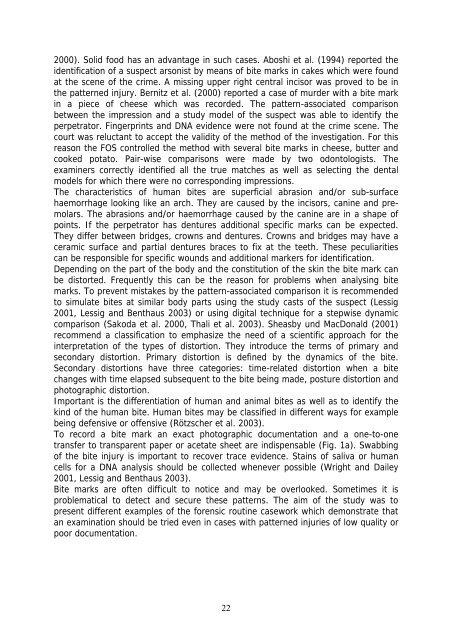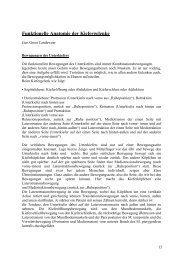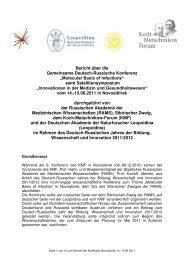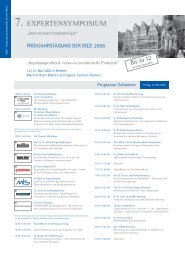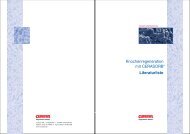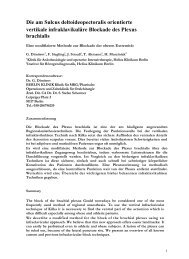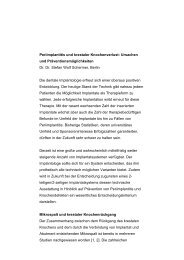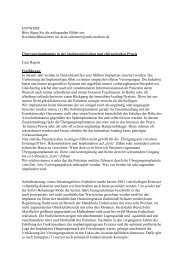NEWSLETTER AKFOS (2008) Jahr 15: No.1 - Berlin Klinik
NEWSLETTER AKFOS (2008) Jahr 15: No.1 - Berlin Klinik
NEWSLETTER AKFOS (2008) Jahr 15: No.1 - Berlin Klinik
Erfolgreiche ePaper selbst erstellen
Machen Sie aus Ihren PDF Publikationen ein blätterbares Flipbook mit unserer einzigartigen Google optimierten e-Paper Software.
2000). Solid food has an advantage in such cases. Aboshi et al. (1994) reported the<br />
identification of a suspect arsonist by means of bite marks in cakes which were found<br />
at the scene of the crime. A missing upper right central incisor was proved to be in<br />
the patterned injury. Bernitz et al. (2000) reported a case of murder with a bite mark<br />
in a piece of cheese which was recorded. The pattern-associated comparison<br />
between the impression and a study model of the suspect was able to identify the<br />
perpetrator. Fingerprints and DNA evidence were not found at the crime scene. The<br />
court was reluctant to accept the validity of the method of the investigation. For this<br />
reason the FOS controlled the method with several bite marks in cheese, butter and<br />
cooked potato. Pair-wise comparisons were made by two odontologists. The<br />
examiners correctly identified all the true matches as well as selecting the dental<br />
models for which there were no corresponding impressions.<br />
The characteristics of human bites are superficial abrasion and/or sub-surface<br />
haemorrhage looking like an arch. They are caused by the incisors, canine and premolars.<br />
The abrasions and/or haemorrhage caused by the canine are in a shape of<br />
points. If the perpetrator has dentures additional specific marks can be expected.<br />
They differ between bridges, crowns and dentures. Crowns and bridges may have a<br />
ceramic surface and partial dentures braces to fix at the teeth. These peculiarities<br />
can be responsible for specific wounds and additional markers for identification.<br />
Depending on the part of the body and the constitution of the skin the bite mark can<br />
be distorted. Frequently this can be the reason for problems when analysing bite<br />
marks. To prevent mistakes by the pattern-associated comparison it is recommended<br />
to simulate bites at similar body parts using the study casts of the suspect (Lessig<br />
2001, Lessig and Benthaus 2003) or using digital technique for a stepwise dynamic<br />
comparison (Sakoda et al. 2000, Thali et al. 2003). Sheasby und MacDonald (2001)<br />
recommend a classification to emphasize the need of a scientific approach for the<br />
interpretation of the types of distortion. They introduce the terms of primary and<br />
secondary distortion. Primary distortion is defined by the dynamics of the bite.<br />
Secondary distortions have three categories: time-related distortion when a bite<br />
changes with time elapsed subsequent to the bite being made, posture distortion and<br />
photographic distortion.<br />
Important is the differentiation of human and animal bites as well as to identify the<br />
kind of the human bite. Human bites may be classified in different ways for example<br />
being defensive or offensive (Rötzscher et al. 2003).<br />
To record a bite mark an exact photographic documentation and a one-to-one<br />
transfer to transparent paper or acetate sheet are indispensable (Fig. 1a). Swabbing<br />
of the bite injury is important to recover trace evidence. Stains of saliva or human<br />
cells for a DNA analysis should be collected whenever possible (Wright and Dailey<br />
2001, Lessig and Benthaus 2003).<br />
Bite marks are often difficult to notice and may be overlooked. Sometimes it is<br />
problematical to detect and secure these patterns. The aim of the study was to<br />
present different examples of the forensic routine casework which demonstrate that<br />
an examination should be tried even in cases with patterned injuries of low quality or<br />
poor documentation.<br />
22


